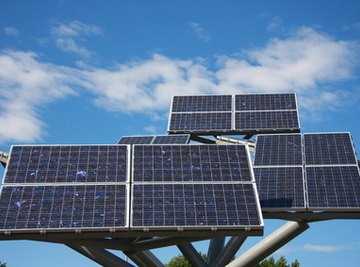
A photovoltaic array, or array of solar panels, converts sunlight into electricity through the use of silicon cells. Because the solar panels don't generate electricity all the time (when the sun is down, for instance), issues of transporting, storing and using the electricity can arise.
How the Electricity Comes Out
Solar panels produce electricity in DC current; the amount of current and the voltage are a function of how many panels you put together into an array. Most arrays output their energy in 12-volt or 24-volt DC current. A high-quality solar panel array has a current regulator built in to make sure that voltage surges from extended periods of sunlight don't damage your wiring or battery systems.
Storing the Energy for Future Use
Because the amount of power a solar panel generates depends on the sunlight it gets, solar panels by themselves cannot be a steady power source. Most solar installation systems include a battery array system, using 12-volt car batteries or 12- or 24-volt marine batteries. The National Renewable Energy Laboratory estimates that about 90 percent of solar power systems output 12-volt DC current, which is compatible with car and marine batteries.
Converting the Electricity for Home Use
While 12-volt car batteries can take and discharge DC current, the vast majority of your home appliances do not. They usually take 120-volt AC power, and converting your DC to AC is the function of a device called an inverter. Inverters are part of a photovoltaic solar system installation, and are just as important as the battery bank.
Safety Concerns
While solar panels are safe, both storage batteries and inverters have some safety concerns. The storage batteries need to be kept in a well-ventilated place so that any vapors that come off of them can be dispersed. The DC-to-AC inverter can get hot when it's under peak load and should be kept away from flammable items. A good electrical contractor or solar system installation contractor, will take these factors into account when installing the photovoltaic power system.
Selling Power Back to the Grid
Your utility company may be required to buy power back from you If you can generate AC current that meets its requirements, or it may be required to run your electric meter backward and apply it as a credit on your bill. Not all utility companies do this, and it varies from municipality to municipality. When the utility company buys back power, it usually buys it at wholesale rates of about 1/4 to 1/5 of the residential rate. When you talk to a solar system installer, ask him what he knows about the local requirements, and then follow up with your utility company.
References
About the Author
Ken Burnside has been writing freelance since 1990, contributing to publications as diverse as "Pyramid" and "Training & Simulations Journal." A Microsoft MVP in Excel, he holds a Bachelor of Arts in English from the University of Alaska. He won the Origins Award for Attack Vector: Tactical, a board game about space combat.
Photo Credits
Solar Panels image by alessbonaventura from Fotolia.com
